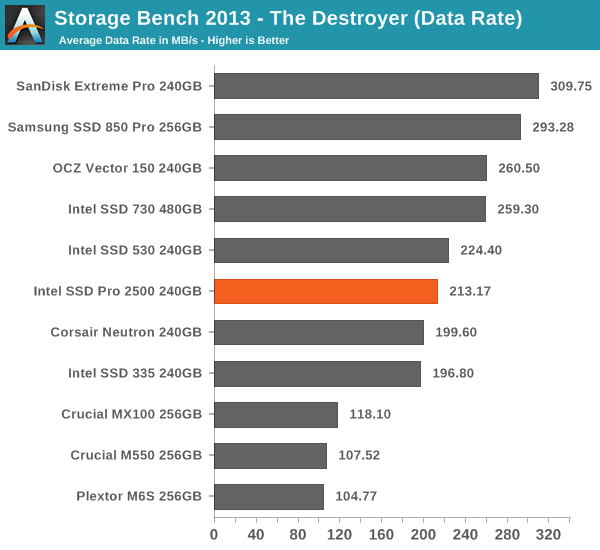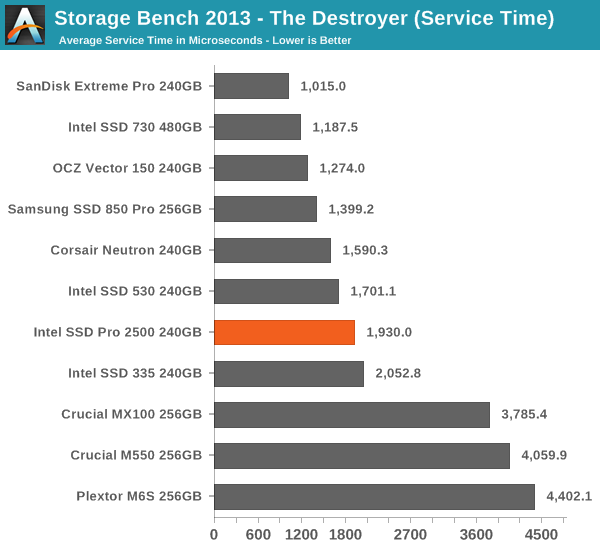Intel SSD Pro 2500 (240GB) Review
by Kristian Vättö on July 30, 2014 5:00 AM ESTAnandTech Storage Bench 2013
Our Storage Bench 2013 focuses on worst-case multitasking and IO consistency. Similar to our earlier Storage Benches, the test is still application trace based - we record all IO requests made to a test system and play them back on the drive we are testing and run statistical analysis on the drive's responses. There are 49.8 million IO operations in total with 1583.0GB of reads and 875.6GB of writes. I'm not including the full description of the test for better readability, so make sure to read our Storage Bench 2013 introduction for the full details.
| AnandTech Storage Bench 2013 - The Destroyer | ||
| Workload | Description | Applications Used |
| Photo Sync/Editing | Import images, edit, export | Adobe Photoshop CS6, Adobe Lightroom 4, Dropbox |
| Gaming | Download/install games, play games | Steam, Deus Ex, Skyrim, Starcraft 2, BioShock Infinite |
| Virtualization | Run/manage VM, use general apps inside VM | VirtualBox |
| General Productivity | Browse the web, manage local email, copy files, encrypt/decrypt files, backup system, download content, virus/malware scan | Chrome, IE10, Outlook, Windows 8, AxCrypt, uTorrent, AdAware |
| Video Playback | Copy and watch movies | Windows 8 |
| Application Development | Compile projects, check out code, download code samples | Visual Studio 2012 |
We are reporting two primary metrics with the Destroyer: average data rate in MB/s and average service time in microseconds. The former gives you an idea of the throughput of the drive during the time that it was running the test workload. This can be a very good indication of overall performance. What average data rate doesn't do a good job of is taking into account response time of very bursty (read: high queue depth) IO. By reporting average service time we heavily weigh latency for queued IOs. You'll note that this is a metric we have been reporting in our enterprise benchmarks for a while now. With the client tests maturing, the time was right for a little convergence.

The Pro 2500 ends up between the SSD 335 and SSD 530 in our 2013 Storage Bench. It is evident that the SF-2281 is showing its age and cannot compete with the latest high-end drives but for typical corporate workloads the performance is more than sufficient.











42 Comments
View All Comments
hahmed330 - Wednesday, July 30, 2014 - link
This SSD doesn't deserve the prefix pro...JellyRoll - Wednesday, July 30, 2014 - link
"the Pro 2500 is another example of Intel's lack of interest and innovation in the client space."That is an interesting comment, based upon that fact that this drive isn't intended to address that space, period. I think there might be a bit of a lack of understanding between the two markets.
The business-class SSD market is growing very fast right now, and Intel is wise to address it. Who wouldn't? Haven't you noticed every other SSD player is entering this very same space? Perhaps there is a reason for that. Businesses are looking for different metrics than an obviously consumer-slanted writer understands. Reliability above performance, extended and proven track record (SF) makes it much easier to get through qual cycles. There are so many aspects of this market that the Pro addresses, but were ignored.
...and there's more, "The problem is that TCG Opal 2.0 and eDrive will never become consumer friendly features if manufacturers do not include them in their client drives, which is what happens if there is a separate business lineup."
Again, the focus on consumer market, where no other SSD manufacturer is developing these for the consumer market for a reason. These features often add export restrictions, which are totally unneeded for the consumer segment, where maybe 1% will utilize those features, even with broad acceptance.
stickmansam - Thursday, July 31, 2014 - link
Just saying but Samsung has those features, Crucial, Adata, Corsair and maybe PNY and Transcend, maybe OCZ?Kristian Vättö - Thursday, July 31, 2014 - link
"Haven't you noticed every other SSD player is entering this very same space?"Not everyone is. Out of the big players, only SanDisk's and Intel's strategy is to separate the client and business SSDs. Samsung and Crucial are going with an all-in-one approach by implementing the security features to their client SSDs.
Reliability is always a moot point because there is no sufficient data to back it up. Sure Intel has always been reliable but the days of Intel being the only reliable OEM are far behind. Crucial, Samsung and SanDisk can certainly match Intel in terms of reliability.
It's true that I'm not an IT admin but the points Intel are using to sell the drive (security features and reliability) aren't unique.
Michael REMY - Thursday, July 31, 2014 - link
you forget to think as a IT/pro manager : what it matters the more is the price in time. And this "pro" version have a longer warranty than usual public version. In firms, Money always counts more than performances, specially on long time term.
Kristian Vättö - Thursday, July 31, 2014 - link
The SSD 530 carries the same 5-year warranty and if warranty really counts, then the 850 Pro is the king with its 10-year warranty (Extreme Pro has 10 years too but no security features).FunBunny2 - Thursday, July 31, 2014 - link
go to Zolt's site, http://www.storagesearch.com/ and take a look at who's really making real Enterprise SSD. If you recognize even 1% of the names, I'll eat my hat. It's a pork pie, so I suppose it'll taste good, if need be.stickmansam - Thursday, July 31, 2014 - link
that site's top SSD companies is ranked by search volume...gospadin - Friday, August 1, 2014 - link
Exactly. Search volume on that site, and not ranked by sales or profit.FunBunny2 - Friday, August 1, 2014 - link
The "rankings" he publishes are the least, by far and away, interesting thing. How Enterprise SSD companies go about their business is what's important. That, and the technical bits about how DRAM/SSD and NAND/SSD work.At one time, Timex sold the most watches. Not very good ones, of course. Drek SATA SSDs are in the same class. They aren't Enterprise Storage.